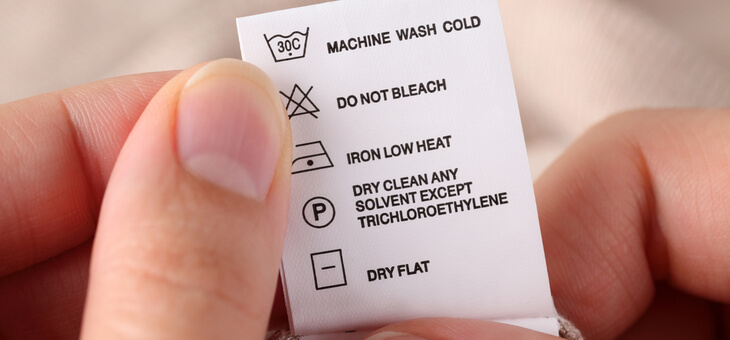They are confusing, confounding and very often ignored. They are laundry care symbols on our clothes, and here’s our guide to working them out.
Unless it’s a rogue manufacturer, generally anything with a bucket shows how the garment can be washed.
If it has a number in it, that’s the temperature guide. Requiring a little bit more brain power is the dot method.
One dot in the bucket symbolises cold or low temperatures, two dots is up to 40°C – and then it goes up a dot for each 10 degrees until you get to six dots, which is 95°C. At that point you are probably cooking your clothes rather than cleaning them, and anything that survives washing at that temperature will probably last forever.
Read: When laundry day was a serious workout
A line under the bucket indicates a mild wash, and two lines, you’ve guessed it, a very mild wash. So less detergent or a gentle detergent.
A hand in the bucket means the garment should be handwashed and a cross through it means don’t machine wash it, and this is usually followed by the preferred method of washing.
A square with a circle in it indicates suitable dryer settings. One dot in the middle is a low setting, two for medium and three for high setting. One big dot does not mean really go for it, like you would expect, but instead that the garment should be dried without heat.
The symbol that looks vaguely like an iron is in fact an iron and once again will have a temperature guide using dots or numbers. A cross through it means don’t iron, and don’t we wish there were more of those?
Read: How often should you wash your bedsheets?
A circle symbol means the garment should be dry cleaned. Hand it over to the dry cleaner and let them deal with it.
Although for many garments ‘dry clean only’ is a warning that can often be ignored, saving money and time.
Legally manufacturers only have to put one method of cleaning clothes and ‘dry clean only’ can be a lazy go-to to cover all bases.
Very often gentle handwashing in a suitable detergent works just as well, although there are some fabrics that should always be dry cleaned including suede, leather, velvet and any garments with a lot of embellishments such as embroidery and sequins.
Read: How to make your white shoes look new again
We are also being led astray with the description of ‘dry’ cleaning.
Dry cleaning refers to the fact that the process doesn’t use water, just chemicals, usually perchloroethylene or ‘perc’, which explains the smell when you pass through the dry cleaner’s door.
Choosing a suitable laundry detergent is often a matter of personal choice, although delicates should definitely be washed in an appropriate detergent.
Cheaper detergents are, well, cheaper, and often do an okay job, but usually use more ‘filler’ to active cleaner agents than the more expensive products. But if your clothes aren’t terribly dirty, does it matter? In fact, quite often it’s possible to use less product than the recommended dose in the more concentrated detergents, so make an informed choice to your personal preferences.
If you enjoy our content, don’t keep it to yourself. Share our free eNews with your friends and encourage them to sign up.

